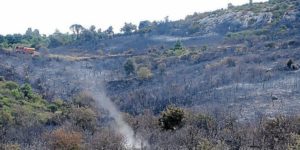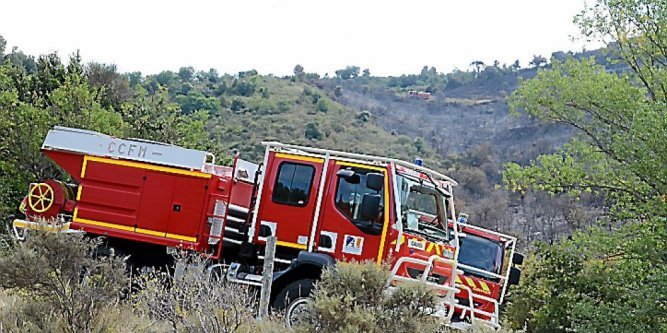 Summer time and the fires are raging. Friday evening, plants are being watered, boxes packed and ready for Saturday’s markets. The water seems to be working again after 10 days of being blocked, a dead snake jammed the our pipe of our well. I stink of rotting snake after spending two hours of being groin deep in a well full of stale water and bits of decomposing serpent. What is that smell other smell? Oh hell it smells like fire. Looking up beyond Maisons towards towards Davejean there is smoke billowing into the sky.
Summer time and the fires are raging. Friday evening, plants are being watered, boxes packed and ready for Saturday’s markets. The water seems to be working again after 10 days of being blocked, a dead snake jammed the our pipe of our well. I stink of rotting snake after spending two hours of being groin deep in a well full of stale water and bits of decomposing serpent. What is that smell other smell? Oh hell it smells like fire. Looking up beyond Maisons towards towards Davejean there is smoke billowing into the sky.
In the distance we can hear the sirens of the fire trucks, a spotter plane is circling in the sky. Within minutes the drone of the Canadairs coming up from the coast can be heard, usually they appear in pairs but this time there is four of them, flying in line. They drop down low and fly into the smoke, they bank round and commence their bombing run, once emptied they head back to the etangs near Coursan on the coast to refill. A larger four engine plane arrives, the orange tanks of retardant strapped to it’s under carriage. It too dives down to drop it’s load before heading back to Bezier airport to refill. More and more firemen arrive, until we have four entire units in place. White ash starts falling out of the sky on our heads.
The fire itself is high above the village, with few points of access, it started by the road and quickly climbed up the hill top. The larger fire pumps have difficulty getting into strategic places so the Landrovers are used to take in crews and equipment. Within the space of two hours the fire is under control. The fire crews stay in place all night in case of re-ignition, a smaller crew will stay around for three days to keep an eye on the ashes.
It is all very dramatic, and not a little worrying. It turns out that the fire service managed to limit the area burnt to 25 hectares, a mere postal stamp compared to the last year’s blaze that destroyed 1,200 hectares of land on the other side of Mont Tauch. Also unlike 80% of the wild fires that annual ravage the South of France, our fire was an accident and not started deliberately. A municipal employee strimming the road side ditches set the fire off. The bone dry vegetation aided by a light wind quickly spread the blaze. Bet someone feels a little foolish.
It did bring home what one of our hunter’ told me, during the Summer it is it a good idea to not to saw down trees in the forest. I thought he was being a bit over dramatic at the time. Now it makes sense, chain saws generate a lot of heat and could easily start an unintentional fire. Forestry management is now strictly a Spring, and Winter activity for me.
The issue of wild fires does also raises a few broader important issues. The first is that the decline of agricultural activity is changing the nature of the Southern countryside and actually raising the risk of fire. The second is that forest management, both in the public sector and the private sector has not put fire protection high on the agenda.The last but not least is the impact of climate change of on the Mediterranean basin.
I have already written a fair amount on the economic decline of the Haut Corbieres, particularly in the agricultural sector, so I won’t repeat my self and bore you all to death again. However the key issue is that the fact that more and more land is not worked and has been left to slowly transform itself into Garrigue, the low level scrub, that in Summer time is basically a tinder box for the arsonist, the lit cigarette thrown out of a car window, or the municipal worker stimming the ditches. In this month’s publication of the Society for Risk Analysis, two French experts in biodiversity and forest fire management, Thibaut Fréjaville and Thomas Curt, argue that present government policy does not actually concentrate on the most important issue, fire prevention. According to The Guardian (You don’t think I actually subscribe to such an august journal do you?) they argue
“that official policy places too little emphasis on prevention in the first place, while bans on fire use for agricultural purposes have led to the disappearance of a “fire-wise” culture among communities. ..the suppression policy itself may even have resulted in the build-up of biomass that increases the hazard of massive fires and lengthens the wildfire “season”. Strongly questioning the sustainability of the fire policy pursued by France and other Mediterranean countries, the authors warn that the approach could be the origin of a new generation of wildfires that will prove even more intense and difficult to suppress.”
The full article can be found here https://www.theguardian.com/world/2017/jul/29/wildfires-provence-locals-blame-climate-change-arson
The second issue is the of forest management. The forests of the Corbieres are on the whole very young, and of poor quality. The environmental impact of the French revolution was one of land clearance and over grazing which in turn led to soil degradation. The rich forests of the Trencaval era have been replaced by stunted green and white oaks struggling to push their roots down into the dust and rock. Profitable forest management is difficult. Communal forest land, managed by the Office nationale de forêts ,ONF, have,,round here anyway,concentrated on fast growing pine trees. They are easier to manage than slow growing deciduous trees, and they and more profitable. The downside are three fold, they are very flammable when dry, they create an ecological desert beneath their branches, and they are ugly. Private forest management is virtually none existent, it is just not profitable. an aging population lacks the personnel as well as the interest managing the dense low level forest that have grown over our long neglected hills sides.
Last but not least is the impact of climate change on the Mediterranean basin.
According to the ICUN
“The last report from the International Panel on Climate Change (IPPC, 2013) highlights the Mediterranean as one of the most vulnerable regions in the world to the impacts of global warming. The models issued by IPCC cast different scenarios for the Region, but all of them agreed on a clear trend in the pattern of some climatic parameters. In terms of the thermal regime, the base scenario from 1980-2000 was used to estimate an increase in average surface temperatures in the range of 2.2 and 5.1 °C for the period 2080-2100. For the same period, the models indicate pronounced rainfall regime changes in the Mediterranean, and estimate that precipitation over lands might vary between -4% and -27%.
Very few studies on the consequences that climate change could produce on species distribution and habitat features and ecosystems structure indicates that a serious alteration of biological and ecological patterns in both marine and terrestrial biomes is already taking place and generating mostly negative rather than positive impacts.”
Lower rainfalls, equals dryer vegetation, which in turn increases the risk of fire.
We had a lucky escape yesterday, sadly we can expect more fires.
The photos I used were shamelessly half inched from this article in Midi Libre
http://www.midilibre.fr/2017/07/30/aude-25-hectares-de-pinede-partis-en-fumee-a-davejean,1542468.php

